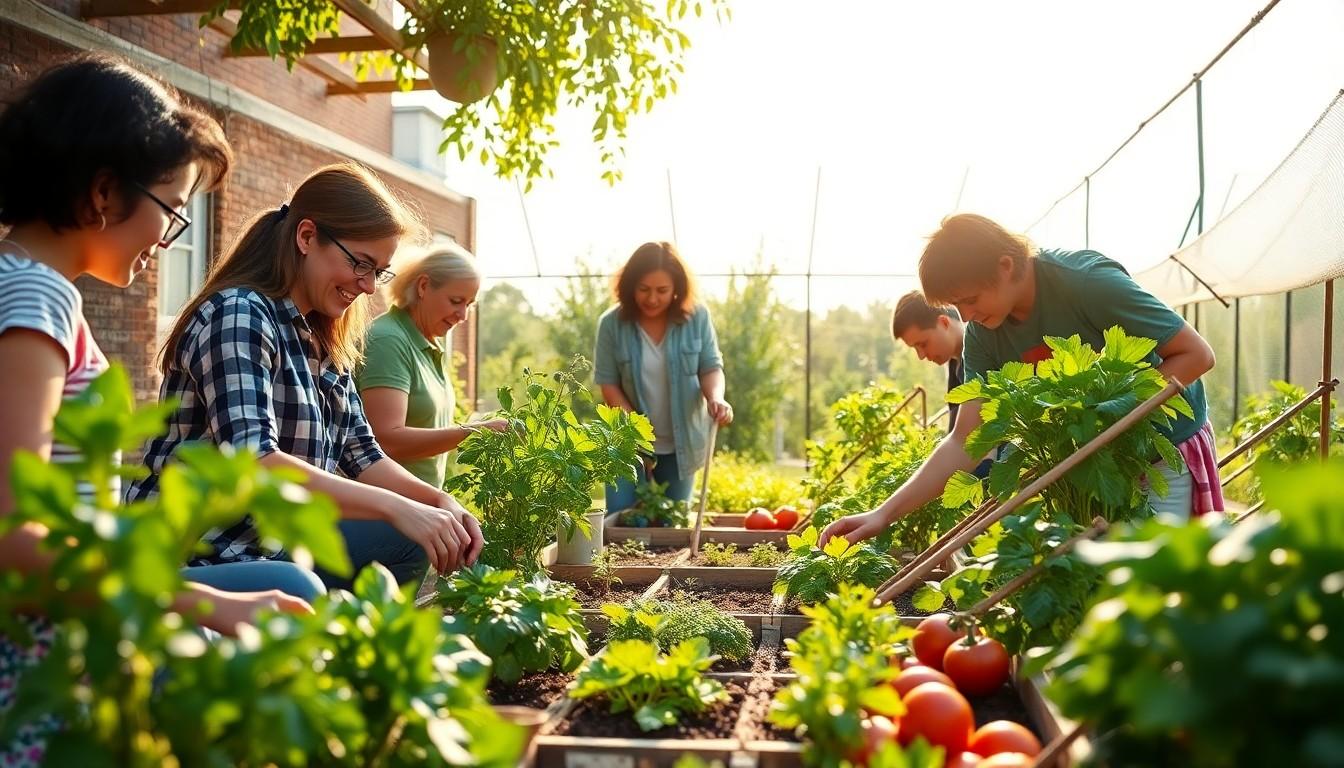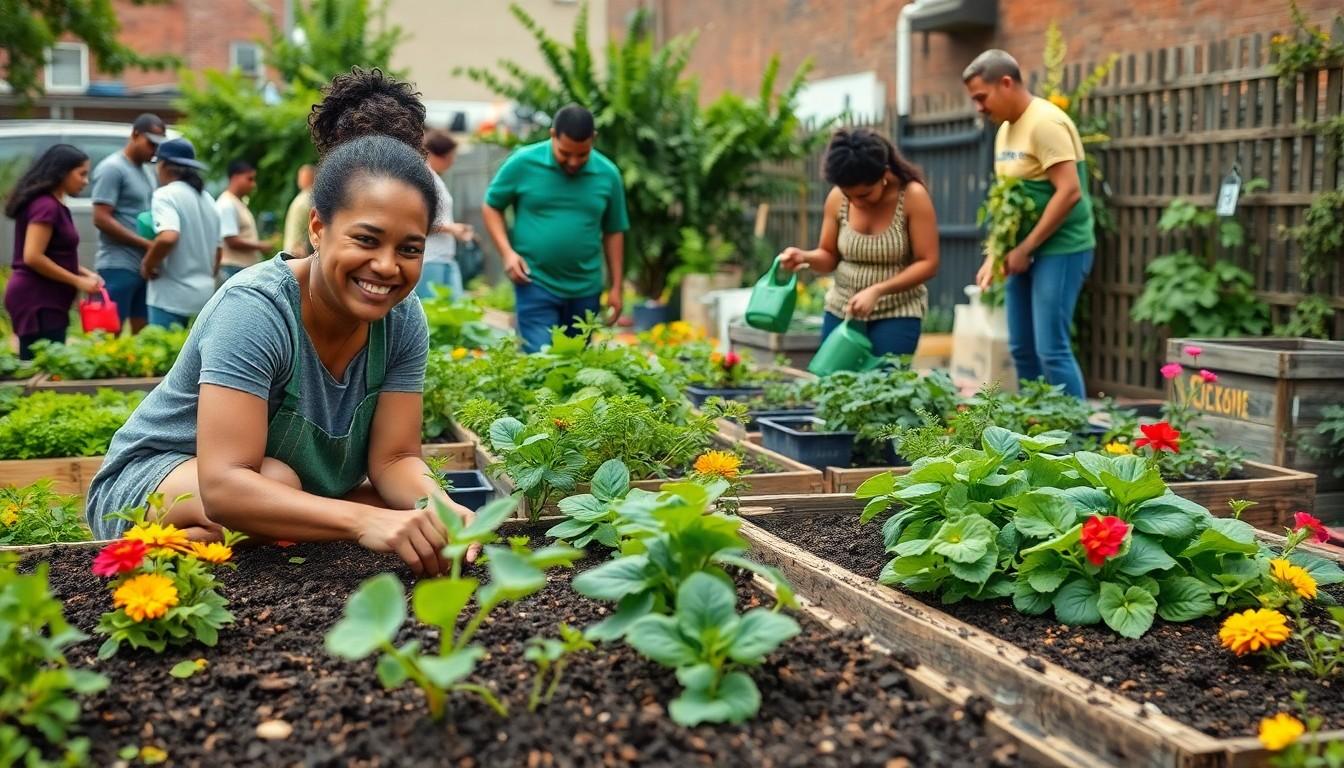In a world where plastic bags seem to multiply like rabbits and climate change feels like an unwelcome houseguest, sustainable living projects are stepping up to the plate. These initiatives aren’t just about hugging trees and chanting “save the planet” in a tie-dye shirt. They’re practical, innovative, and yes, even a bit fun. Imagine turning your backyard into a mini-eco paradise while impressing your neighbors with your newfound green thumb.
Sustainable Living Projects
Sustainable living projects address the urgent need to reduce reliance on plastic and combat climate change. These initiatives encompass various activities that promote eco-friendly practices, such as urban gardening, community composting, and renewable energy installations. Implementing solar panels reduces carbon footprints while conserving energy and cutting utility bills.
Creating local farmers’ markets strengthens community ties and encourages the consumption of organic produce. Integrating rainwater harvesting systems allows households to minimize water waste and lessen the impact of droughts. Each project serves as a practical solution that participants can enjoy while enhancing their living spaces.
Prominent examples of sustainable living projects include permaculture gardens, which mimic natural ecosystems to improve soil health. Recycling programs empower communities to transform waste into reusable materials, fostering a culture of sustainability. Additionally, green building practices focus on using sustainable materials and energy-efficient designs, resulting in lower environmental impact.
Educational workshops often accompany these projects, equipping participants with knowledge and skills needed for sustainable practices. Encouraging participation in local initiatives boosts awareness and highlights the importance of individual contributions to larger sustainability efforts. Through collaborative actions, communities create lasting change while promoting a cleaner, greener environment.
Benefits of Sustainable Living Projects

Sustainable living projects offer significant advantages, positively affecting both the environment and society.
Environmental Impact
Reducing carbon footprints marks a primary benefit of sustainable living projects. Urban gardening initiatives use minimal space to grow fresh produce, limiting the need for transportation and reducing emissions. Composting systems transform waste into valuable soil nutrients, effectively diverting organic materials from landfills. Renewable energy installations, including solar panels, generate clean energy, decreasing dependence on fossil fuels. Additionally, rainwater harvesting systems capture and reuse water, significantly lowering waste. Such efforts support biodiversity, promoting healthier ecosystems. By enhancing local environments, these projects showcase practical methods to combat climate change directly.
Social Advantages
Social cohesion results from engaging in sustainable living projects. Community gardens create shared spaces that encourage collaboration and knowledge exchange among residents. Educational workshops provide vital skills, empowering individuals to adopt sustainable practices in their daily lives. As local farmers’ markets emerge, they foster relationships between consumers and producers, reinforcing community ties. Increased access to organic produce contributes to improved public health outcomes. Involvement in these projects also cultivates a sense of purpose and belonging. These advantages demonstrate that sustainable living projects benefit both individuals and communities holistically.
Examples of Successful Sustainable Living Projects
Numerous successful sustainable living projects demonstrate innovative approaches to environmental and community challenges.
Urban Community Gardens
Urban community gardens showcase how grassroots initiatives can transform city landscapes. These gardens strengthen community bonds and provide fresh produce. Many residents cultivate their own food, reducing dependency on store-bought items. In cities like New York and Chicago, community gardens exist in every neighborhood, promoting biodiversity. Access to local organic produce enhances public health and wellness. Workshops often accompany these gardens, teaching essential gardening skills and sustainable practices. Each garden often acts as a hub of social interaction, where diverse individuals collaborate and exchange knowledge.
Renewable Energy Initiatives
Renewable energy initiatives represent a pivotal shift toward sustainable living. Solar panel installations have surged in urban and rural areas, providing clean energy and reducing utility costs. Cities like San Diego and Austin lead in solar energy adoption, boosting local economies. Wind energy projects also thrive in various regions, harnessing natural resources for electricity generation. Community solar programs enable collective investment in renewable energy, allowing participants to benefit even without installing panels. Educational outreach promotes awareness about energy efficiency. Collectively, these initiatives foster environmental sustainability while supporting local job creation.
Challenges in Implementing Sustainable Living Projects
Sustainable living projects face several challenges that can hinder their success. Key obstacles include financial constraints and community engagement issues, both of which significantly impact project feasibility.
Financial Constraints
Funding remains a critical barrier for many sustainable living initiatives. Limited budgets can restrict the scope of projects, preventing necessary advancements. Initial costs for implementing energy-efficient systems, such as solar panels, often deter participation. Grants and subsidies from government sources may reduce expenses but are not guaranteed. Community members might hesitate to contribute financially without clear evidence of long-term benefits. Sustainability requires investment, yet many projects struggle to secure adequate resources. Reducing reliance on external funding can enhance project sustainability and self-sufficiency.
Community Engagement
Active participation from the community proves vital for the success of sustainable living projects. Engaging local residents encourages shared responsibility and investment in project outcomes. Challenges arise when individuals lack awareness of sustainable practices or the benefits derived from participation. Communication strategies play a significant role in fostering interest and understanding. Organizing workshops, events, and outreach programs can attract community members and promote collaboration. Addressing diverse needs and interests helps ensure broader engagement. Ultimately, community involvement strengthens the foundation for lasting sustainability initiatives and enriches local connections.
Building Stronger Communities
Sustainable living projects represent a vital shift toward a healthier planet and stronger communities. By embracing these initiatives, individuals can actively participate in reducing their carbon footprints while fostering connections with their neighbors. The journey toward sustainability isn’t just about environmental impact; it’s also about creating vibrant spaces that enhance quality of life.
As more people engage in urban gardening, renewable energy solutions, and community-driven efforts, the collective impact becomes significant. Each project serves as a stepping stone toward a more sustainable future, proving that local actions can lead to global change. With continued commitment and collaboration, the vision of a cleaner and greener world is within reach.




